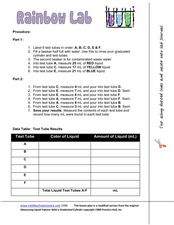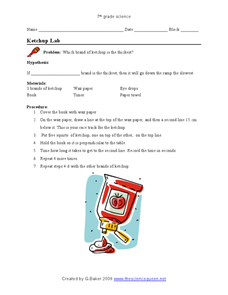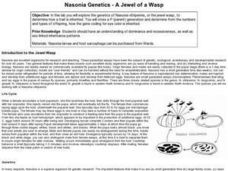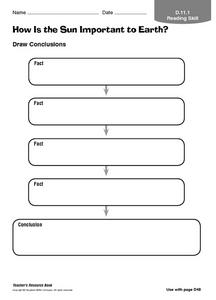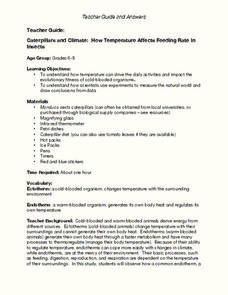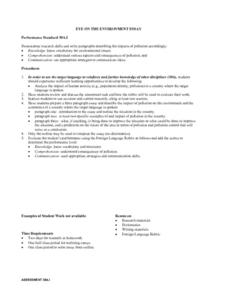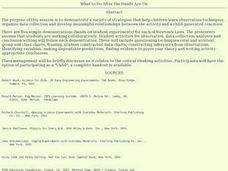Curated OER
Dunkin` for Density
In this density activity, students complete a science lab experiment to determine the density that an object will float or sink in water. Students fill in a chart with their data, answer 4 short answer questions and write 1 conclusion...
Curated OER
Gravity Gets You Down
Students design an experiment to investigate how objects with different masses fall. For this physics lesson, students predict how these objects will fall in a vacuum tube. They write a report explaining experimental results and conclusion.
Curated OER
Why Muscle Biology?
Students research and define a muscle biology research question and organize an experiment to address the question utilizing either NADH staining or acid buffering. They analyze data as well as draw conclusions about their research....
Curated OER
Venn Diagram Dolphins And Whales
In this compare and contrast worksheet, students use a Venn diagram to show similarities and differences in dolphins and whales. There is space for students to write a conclusion.
Curated OER
Experimental Design Practice
In this experimental design worksheet, students are given two experimental scenarios to read. They answer questions about each including finding the hypothesis, the independent and dependent variables and controls. They design a graph...
Curated OER
Conservation of Mass
In this conservation of mass worksheet, students experiment with vinegar, baking soda, a balloon and a flask. They compare the mass of the closed system of reactants before the experiment to the mass of the products after the experiment...
Curated OER
Rainbow Lab
In this mixtures activity, students experiment with different amounts of solutes and solvents to make solutions. They observe color changes and look for chemical and physical changes in the test tubes. Students answer 5 questions and...
Curated OER
Types of Chemical Reactions Lab
In this chemical reactions activity, students experiment with several different reactions and identify each as a single replacement, double replacement, synthesis, decomposition or combustion reaction. Students observe the changes in...
Curated OER
Ketchup Lab
In this ketchup activity, students investigate the thickness of different types of ketchup. They hypothesize, identify their independent and dependent variables, test their hypothesis and write conclusions based on their data.
Curated OER
Nasonia Genetics-A Jewel of a Wasp
Students investigate the inheritance pattern of eye color in Nasonia wasps. In this genetics and inheritance lesson plan, students read about the life cycle of Nasonia wasps and hypothesize about the possibilities of eye color inherited...
Curated OER
Properties of Air
Fourth graders participate in a demonstration lesson using bubbles in which they determine that air fills the bubbles. Next, they work in small groups as they they experiment with the properties of air at separate work stations. After...
Curated OER
How Do Their Parts Help Plants Survive?
In this plant survival worksheet, students will write down 3 facts about the parts of a cactus plant. Then students will write in a conclusion about how those parts help the cactus survive.
Curated OER
How is the Sun Important to the Earth?
In this sun worksheet, students will write down 4 facts about the sun and come up with a conclusion about the importance of the sun based on their facts. This worksheet is a graphic organizer.
Curated OER
Solving Problems
For this solving problems worksheet, learners answer twelve multiple choice questions about problem solving in science and the steps of the scientific method. These include identifying the problem, forming a hypothesis and setting up the...
Curated OER
What is an Electric Current?
In this electric current worksheet, students will write down three facts about electric currents. Based on these facts, students will come up with a conclusion as to what an electric current is.
Curated OER
Dude, Who Hit My Car?
Learners discuss how investigators solve a hit and run accident. In this physical science lesson, students recreate an accident scene using CEENBot. They collect data from the experiment and formulate conclusion.
Curated OER
What's the Rub? It's All About Friction!
Students determine the coefficient of friction for different surfaces. In this physics lesson plan, students identify the factors that affect friction. They collect data and write a formal lab report.
University of Georgia
Stoichiometry of S'mores
How fun would it be to teach the concept of stoichiometry while allowing your chemistry class to assemble a classic campfire treat? This fun and engaging activity allows pupils to explore the principles of the chemical theory while...
Curated OER
Caterpillars and Climate: How Temperature Affects Feeding Rate In Insects
Do you eat more when you are hot or when you are cold? Young scientists observe the eating pace of two caterpillars at different temperatures. The differences in endotherm and ecotherm animals' ability to adjust to temperature change...
Curated OER
Scientific Method Conclusion- Adjective Practice
For this adjectives worksheet, students write adjectives that describe a well-written scientific conclusion on lines around a light bulb, then write a sentence for 4 of the adjectives used.
Curated OER
Take the Lead — Get the Lead Out
Students research about the physiological effects of prolonged lead exposure. In this chemistry lesson, students investigate the lead content of different paint, soil and water samples. They analyze data trends and share their findings...
Curated OER
Greek Inquiry Report and Presentation
Sixth graders choose from a list of researchable inquiry questions. They engage in all phases of inquiry/research process.
Curated OER
Eye On the Environment Essay
High schoolers analyze the impact of human activity (e.g., population density, pollution) to a country where the target language is spoken. They prepare a three paragraph essay and describe the impact of pollution on the environment...
Curated OER
What To Do After The Hands-Are-On
Young scholars perform various demonstrations for each of Newton's Laws, collect data, and write a conclusion for each.






